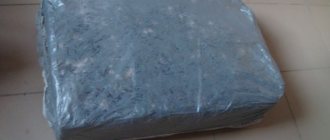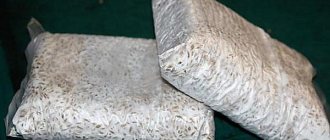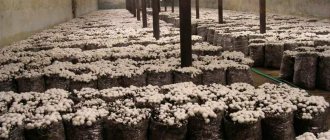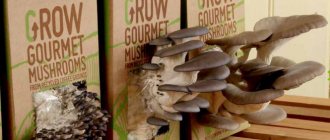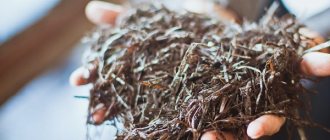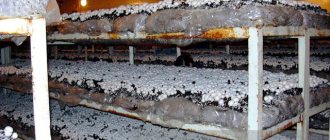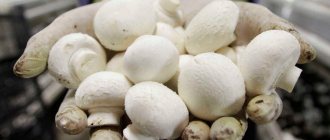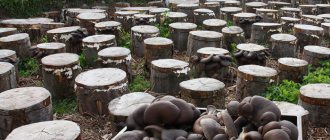The microclimatic conditions of the cellar are ideal for growing mushrooms. Anyone can buy mycelium and master the technology of growing champignons in the basement. If you want to get a good harvest, first of all, you should pay attention to such things as: preparation of the nutrient substrate, room equipment, disinfection, temperature and humidity control. Let's look at these and other questions in order.
What should the cellar be like?
You can grow mushrooms in any well-made cellar. The floor in the cellar should be concrete, not earthen. In general, the cleaner and more insulated from external influences the room is, the better.
To save space in the basement, racks with mushrooms are arranged in several floors (tiers).
Lighting
Unlike green onions and other plants, champignons do not need additional lighting. They can be grown perfectly in the dark. The light bulb should be screwed in only to make it convenient to work in the cellar or basement.
Ventilation
The cellar must be equipped with a ventilation system, since the compost on which the champignons grow actively releases carbon dioxide during decomposition. But mushrooms cannot tolerate mustiness. Carbon dioxide must be removed and fresh air supplied in its place. However, drafts should not be allowed. The ventilation pipes are covered with fine mesh to prevent insects from getting inside.
If conventional supply and exhaust pipes are not enough for good ventilation of the cellar. You will have to take care of forced ventilation of the room. To organize air circulation above the boxes with champignons, you can use additional fans. If possible, it is worth installing additional air purification filters.
Temperature and humidity
To monitor these indicators, install a thermometer and hygrometer in the room for growing champignons. You can increase the humidity by spraying the shelving and floors with a spray bottle. Reduce through ventilation.
The temperature in the summer can be regulated with the help of ventilation, but if you plan to grow champignons all year round, take care of additional heating of the cellar.
Space zoning
If your cellar is large enough, it makes sense to divide it into two zones. You will use one room for incubation (spread of mycelium over the substrate), and the second for direct forcing of mushrooms (fruiting bodies). The temperature required for the successful completion of these processes is different. The mycelium grows at approximately 23 degrees, and fruiting occurs at 16–17 degrees.
By maintaining stable temperature conditions in each room, you can simply move the boxes with the substrate. In this way, you can grow champignons continuously - while half of the boxes bear fruit, mycelium grows in the other, and so on. If necessary, you can add a third zone for composting.
Pre-disinfection
To grow mushrooms, the basement must be thoroughly disinfected and treated against parasites and mold. Champignons are very sensitive to diseases and pests, and it would be a shame to lose most of the harvest due to neglect of safety measures at the initial stage.
In particular, the following processing can be carried out:
- Fumigate with a sulfur bomb.
- Whitewash the walls and ceiling with lime and copper sulfate.
- Spray with a 4% formaldehyde solution.
- If there were previously vegetables in the basement, and fruit flies or other pests have infested, you need to treat the room with chlorophos.
- As an additional protective measure, you can place a box of sawdust soaked in a disinfectant solution at the entrance.
After disinfection, the basement should be thoroughly ventilated, otherwise it will be very difficult not only for the champignons, but also for you to stay inside.
How to prepare a nutrient medium for future mushrooms?
The main factor for a successful enterprise is absolute sterility . If, during the propagation process, mold gets into the environment where the mycelium develops, the entire batch will be spoiled. Inventory, equipment, utensils, and even your work clothes are subject to disinfection. The table on which work will be carried out must be covered with glass and thoroughly wiped with alcohol. The premises where containers with seedlings will be kept must also be systematically disinfected.
Substrate preparation
Preparing a nutrient medium on which champignons will grow is one of the most important and responsible moments. To grow maximum yield, you should prepare the substrate according to the recommendations on the package of mycelium you purchased. Since the strains or varieties of champignons are different, the preparation technology and the composition of the substrate may vary slightly.
This is what the substrate on which champignons grow looks like.
However, there are general principles for preparing compost for growing champignons, which can be considered universal. The best option would be natural compost made from horse manure. It is important that animals eat hay and not green food.
Two options for preparing natural compost:
| № | Ingredients | Weight, kg |
| 1 | Horse manure with high straw content, humidity 40–45% | 850 |
| Urea | 3 | |
| Superphosphate | 13 | |
| Ammonium nitrate | 8 | |
| Gypsum | 18 | |
| 2 | Horse dung | 2000 |
| Straw | 50 | |
| Urea | 5 | |
| Ammonium sulfate | 8 | |
| Superphosphate | 5 | |
| Chalk | 7,5 | |
| Alabaster |
Horse manure can be replaced with cow or bird droppings, however, in this case the yield will be significantly lower.
The straw is soaked for a day in warm water in a convenient trough or other container. After this, it is stacked mixed with layers of manure. You should get only 6-8 layers. We additionally moisten each layer with warm water. After 3-4 days, the compost needs to be thoroughly mixed and urea and superphosphate added. After this, the substrate will acquire a characteristic ammonia odor. After another 3-4 days, the compost is mixed again. So it needs to be shoveled 4-5 times, gradually adding the remaining minerals. During the final mixing, gypsum is added.
The average compost preparation time is 24–28 days. The completion of the fermentation process can be judged by the disappearance of the ammonia smell and the light brown color of the manure. During the fermentation process, the temperature of the compost can reach 50–70 degrees. To grow mushrooms, the compost temperature should be no more than 25 degrees.
The substrate should be prepared either in a special utility room with good ventilation, or outdoors under a canopy that protects from rainwater and sun. We don’t pour compost on the ground; it’s better to spread cellophane. This is required to ensure that pests do not get into the finished substrate.
If preparing your own substrate for growing mushrooms is too difficult for you, you can always buy it at the store. However, compost made by yourself is usually of better quality.
We move the finished substrate to the basement and place it in boxes or containers in which we plan to grow champignons.
Sowing
Now the formed mycelium must be sown in jars with compost. Let us once again emphasize the need to comply with the conditions of maximum sterility, which can be ensured at home using a burner.
You may also be interested in the article: “How to make your own cover soil for champignons?”
Technology
- Fill the jars ⅔ full with compost, close with soft plastic lids, in which you make small holes in advance.
- Sterilize the dishes in an autoclave for 2 hours, then let them cool to a temperature of +24...+25 °C.
- Place the material from the test tubes into the cooled container with compost.
- Close the jar tightly with a lid.
Planting mushroom mycelium (inoculation)
So, the substrate is ready and placed in the cellar; now you need to add fungal mycelium to it in order to grow mycelium. Mycelium is grown industrially in laboratories under sterile conditions. You can buy it in gardening stores or order it online.
Grain mycelium.
In order to grow mushrooms on 1 square meter of substrate, you will need 500 g of compost mycelium or 400 g of champignon grain spores.
We place the “seeds” in the substrate. If you have prepared the compost correctly, it should spring back slightly when pressed. We make five-centimeter depressions at a distance of 20 centimeters from each other and place a small amount of compost mycelium in each depression. If you purchased champignon spores, you just need to scatter them over the surface. Gradually, the mycelium threads will begin to grow across the substrate.
The time of growth of the mycelium, before the fruiting bodies of the mushrooms have yet appeared, is called incubation. During this period, it is necessary to maintain air humidity in the cellar at 70–95%. To prevent the substrate from drying out, you can cover it with paper or cloth and periodically spray it with a spray bottle.
The temperature at which mycelium grows is 20–27 degrees. Mushroom threads will begin to actively spread within ten to twelve days. Then the surface of the substrate should be covered with 3–4 centimeters of soil and wait another 3–5 days. The soil is not just from the garden, but a mixture of peat (5 parts), limestone (1 part) and soil (4 parts). Do not forget about periodic spraying with water.
Business risks
Business is associated with the following risks:
- Mushrooms die or do not sprout. This is what novice entrepreneurs face when they immediately organize large mushroom plantations. As a result, the entrepreneur suffers losses. To minimize the risk, start a small mushroom growing company initially. In a couple of months, you will understand whether it is worth expanding your company.
- The crop is destroyed by pests and diseases. Ventilation and regular cleaning help reduce the likelihood of losses.
- It was not possible to find buyers. Take care of sales in advance. Otherwise, you will grow too many mushrooms, and mushrooms cannot be stored for a long time.
When creating a business on champignons, take into account the growing conditions of the product - mushrooms are sensitive to the state of the compost and the environment. Find buyers in advance, since mushrooms are a perishable product. If the business is profitable, expand the area. From 300 sq. m. you can collect up to 100 tons of mushrooms per year.
Forcing fruiting bodies
After the incubation period, you should lower the temperature in the cellar to 12–17 degrees, or move the boxes with the substrate to the room for forcing (if, as mentioned at the beginning of the article, you divided the room into two compartments). The period of growth of the mushrooms themselves begins.
In one harvest, 5-8 waves of mushrooms can be removed from the mycelium, although the bulk will fall on the first three waves.
You can harvest the first wave of harvest in 3-4 months. Do not allow mushrooms to overripe. They should be picked when the lower part of the cap is still covered with a white film and the brown plates are not visible. Each mushroom must be carefully unscrewed from its place, and not cut off. Bacteria can enter the mycelium from the stem remaining after the cut.
After collecting the mushroom, the place where it grew should be lightly sprinkled with soil. The mushrooms will grow vigorously within 1-2 weeks. Under the right conditions and good compost, 5–8 mushroom harvests can be harvested during this time. The main volume falls on the first three waves. Then the yield of the mycelium will sharply decline.
Installation of drawers
The small boxes are then manually stacked on top of each other in a staggered double stack.
Drawing of installation of drawers
We place them alternately in 4s and 5s above each other, leaving a passage of 75 cm. You can make a stack even higher, or for the sake of convenience when caring for and cleaning grown champignons, limit yourself to the specified stack height, in any case, each enterprise is guided by its own considerations. The lowest drawers should not stand directly on the floor: at least bricks should be placed at all 4 corners to ensure good ventilation, ease of work and the room can always be thoroughly cleaned. When installing, the question constantly arises whether the stack should be placed along or across the room. The disadvantage of installing along the room is that workers have to walk far when stacking the stack, but the advantage is that the aisle area is reduced and more boxes can be placed without increasing the height of the stack. For reasons of labor management, we have so far preferred a transverse installation and took this into account in advance when constructing rooms for harvesting champignon mushrooms. It should also be noted that the boxes at the ends of the stack must have additional support and for this we use a wooden part. Every now and then the opinion is expressed that the stacked arrangement of the beds supposedly makes it possible to grow higher yields of champignons than staggered stacking of boxes, because this allegedly ensures better aeration of champignon mushroom cultures. That's why the boxes are placed on shelves. For this purpose, the same frame is built as for a rack, where you can place individual boxes.
The best varieties to grow
More than fifty different varieties of champignons are known in the world. Some of them are found in the wild, and some are bred by breeders for industrial breeding.
High-yielding, easy-to-care and unpretentious varieties are ideal for growing in the cellar. Among them we can distinguish two-spore and two-ring. Also suitable for home cultivation are meadow champignon, Somycel 512 and Hauser A15.
The technology for growing champignons in the basement has its own characteristics, but it is not as complicated as it seems at first glance. If you have prepared the correct compost, established the required microclimate in the cellar and purchased good planting material, you are guaranteed a high mushroom yield! And our recommendations will help you cope with this creative and interesting task.
Microclimate in the room for champignons
Amateur cultivation of champignons is possible in open ground. However, this is only possible in areas with a warm and temperate climate, where the frost-free period lasts at least six months.
First of all, you need to build light shelters. With their help, optimal air and temperature conditions are created, and the compost does not overheat. Shelters can be built in the form of a greenhouse (arcs with a stretched film over the ground) or arranged near the wall of a stone building. Recommendations for arranging greenhouses and greenhouses for growing champignons are shown in Figure 7.
Figure 7. Options for greenhouses for growing champignons: a - two-tier greenhouse (1 - wooden wall, 2 - bed, 3 - clay floor, 4 - wooden stand with crossbars, 5 - gable roof, 6 - layer of thermal insulation, 7 - ventilation hole ), b - wall-mounted greenhouse (1 - compost, 2 - brick wall, 3 - concrete blind area, 4 - frame with film), c - compact greenhouse for amateur cultivation (1 - wooden wall, 2 - beds with mushrooms, 3 - earthen floor, 4 - stand, 5 - roof or greenhouse frame, 6 - layer of horse manure, 7 - vent)
You should also follow some recommendations:
- Compost cannot be laid on open ground. To do this, use thick polyethylene film or roofing felt;
- When installing a wall-mounted mushroom maker, it should be located on the north side of the building;
- To grow mushrooms, you can use basements, cellars or natural caves.
